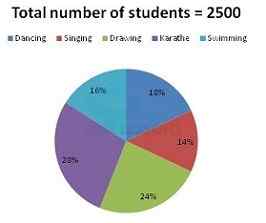 Introduction
Introduction
Data Interpretation is the ability to analyse, interpret and visualise the provided data to arrive at conclusions and to make inferences. Data Interpretation questions in the competitive exams is a test of analytical abilities. In the competitive exams, the Data Interpretation questions are grouped together and refer to the same table, graph or other data/visual presentation. The test takers are required to interpret or analyse the given data to answer the questions. In India, competitive exams related to employment in Banking, SSC, Insurance, etc..have the Data Interpretation type of questions. The article IBPS PO Mains Data Analysis and Interpretation Quiz 2 provides Data Interpretation Practice Quizzes with solutions.
 Quiz
Quiz
Directions (1 – 5): Study the following information carefully and answer the given questions:
Following pie chart – 1 shows the percentage distribution of total number of students (Boys + Girls) enrolled for different activities in School A and the pie
chart -2 shows the percentage distribution of the total number of girl students enrolled for different activities in School A
1. The total number of boy students enrolled in Dancing and Singing together is approximate what percentage of the total number of girl students enrolled for the same activities?
-
A. 86 %
B. 124 %
C. 102 %
D. 68 %
E. 74 %
-
A. 560
B. 700
C. 850
D. 920
E. None of these
-
A. 143 : 212
B. 125 : 198
C. 133 : 248
D. 161 : 264
E. None of these
-
A. 326
B. 378
C. 412
D. 434
E. None of these
-
A. 16 % less
B. 4 % more
C. 4 % less
D. 25 % less
E. 16 % more
Directions (1-5): Study the following information and answer the questions that follow:
There are two companies namely A and B, which sell chairs, tables, and wardrobes in 3 months August, September, and October. The ratio of a chair, tables, and wardrobes sold by A in August are 42: 36: 23 while a ratio of chairs sold by A in August, September, and October is 14: 23: 27. Wardrobes sold by A in August is 230 less than chairs sold in September by A. In September 665 chairs, 400 tables and 210 wardrobes were sold by two companies together. B sold the same number of chairs in Aug and September. The number of tablets sold by company B in September was equal to a number of chairs sold by A in August while the number of wardrobes sold by A in August and B in September was equal. Company B sold a total of 1025 chairs in these three months together which was 480 more than the total number of tables sold by A. Ratio of tables sold by A and B in August is 12: 11 and in October is 35: 38 respectively. The total number of items sold in August was 1075. The total number of wardrobes sold by A in October was 35 less than the wardrobe sold by B in October, while the sum of the wardrobe
sold by A and B in October is 205.
1. What is the ratio of the number of tables sold by A in August to that of B in September?
Required Ratio = [latex]\frac{180}{120}[/latex] = [latex]\frac{6}{7}[/latex]
2. Find the number of wardrobes sold by B in October.
-
A. 7:6
B. 6:7
C. 12:13
D. 11:12
E. None of these
| Month | chair | Table | wardrobe | |||
|---|---|---|---|---|---|---|
| A | B | A | B | A | B | |
| Aug | 210 | 320 | 180 | 165 | 115 | 85 |
| Sep | 345 | 320 | 190 | 210 | 95 | 115 |
| Oct | 405 | 385 | 175 | 190 | 85 | 120 |
-
A. 80
B. 120
C. 115
D. 95
E. 125
-
A. 100
B. 120
C. 105
D. 110
E. 112
-
A. 750
B. 725
C. 705
D. 715
E. 405
-
A. 83%
B. 54%
C. 67%
D. 56%
E. None of these
Directions (1-5): The Table given below shows the percentage of valid voters in 5 villages in two years 2001 and 2005.
NOTE- Total voters in any year = Valid voters + Invalid voters
1. What is the difference between invalid voters of village C in the two given years if valid voters in 2005 in that village are 4000 and the ratio of valid voters of village C from 2001 to 2005 is 19: 25?
| Villlages | 2001 | 2005 |
|---|---|---|
| A | 50 | 80 |
| B | 75 | 65 |
| C | 76 | 64 |
| D | 55 | 70 |
| E | 80 | 55 |
-
A. 1190
B. 1250
C. 1290
D. 1350
E. 1365
-
A. 4400
B. 4600
C. 5400
D. 5200
E. 4800
-
A. 131: 160
B. 130: 161
C. 127: 141
D. 18: 35
E. None of these
-
A. 2%
B. 4%
C. 6%
D. 8%
E. 8%
-
A. 45 [latex]\frac{2}{7}[/latex] %
B. 53 [latex]\frac{4}{5}[/latex] %
C. 53 [latex]\frac{1}{8}[/latex] %
D. 52 [latex]\frac{1}{8}[/latex] %
E. 50 [latex]\frac{2}{5}[/latex] %






